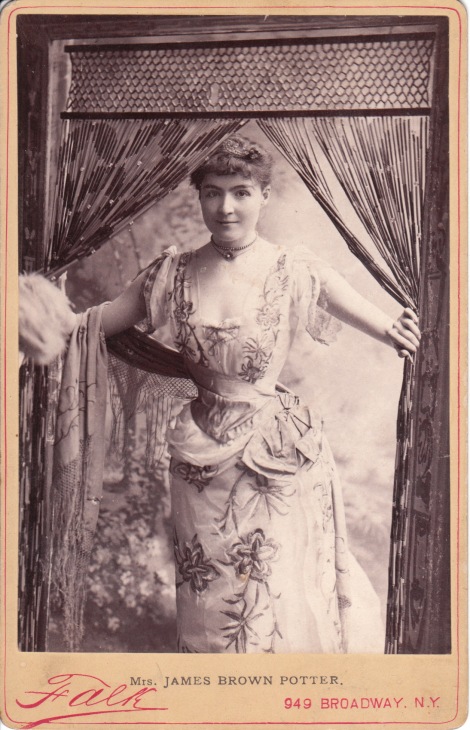In writing about Mrs James Brown Potter, an author stated “She was singularly beautiful with her pale delicate chiseled face, long dark eyes, and hair like burnished bronze with copper lights”. Mrs Brown Potter (1859-1936) was born Mary Cora Urquhart, the daughter of a wealthy New Orleans Colonel. She was one of the first American society women to join the stage. In 1877 she married a very wealth New York socialite, James Brown Potter. That same year she made her stage debut at Theatre Royal in Brighton, England. Soon thereafter, she partnered with actor Kyrle Bellew and they frequently performed together over a ten year period. She performed in the United States and in Europe. She retired from the stage in 1912. She was active in raising money for war charities during the Second Boer War. Mrs Brown Potter was considered a competent actress, but not an outstanding performer.
In the Cabinet Card 1 photograph, Mrs. Potter looks very beautiful as she peers through a curtained doorway. Her gown was likely made by the best dress makers of the time and was assuredly very expensive. Falk, the photographer of this cabinet card, was a famous celebrity photographer in New York City. To see other photographs by Falk, click on the category “Photographer: Falk”. (SOLD)
The Cabinet Card 2 photograph of Cora Potter was photographed by Kuebler of Philadelphia, Pennsylvania. She appears to be in costume and is clearly a beautiful woman with fetching eyes. To view other photographs by and to learn more about Kuebler, click on the category “Photographer: Kuebler”.
The Cabinet Card 3 photograph of Mrs Potter was produced by Jose Maria Mora, a celebrity photographer based in New York City. The image was part of a series (#7). To view other photographs by this photographer, click on the category “Photographer: Mora”. Mrs Potter looks quite elegant in this cabinet card portrait. Her hat can best be described as “floral”. The photograph is stamped on the reverse with the name of the gallery that originally sold it (“John Hoch Art Store, 118 Court Street, Boston”). Hoch’s obituary appears in the Bulletin of Photography and the article reports that he was the first among Boston’s photographers to sell photographs of celebrities. He had been engaged in the photography and picture frame business in Boston for more than fifty years. The obituary mentions that he was of German heritage and was 84 years old at the time of his death. His cause of death was cerebral hemorrhage.
 CABINET CARD 1 (SOLD)
CABINET CARD 1 (SOLD) CABINET CARD CARD 2
CABINET CARD CARD 2 CABINET CARD 3
CABINET CARD 3


